Analysis of Five Ways to Well-being in Health and Social Care Context
VerifiedAdded on 2020/11/12
|8
|1585
|335
Report
AI Summary
This report provides a comprehensive overview of the five ways to well-being (Connect, Be Active, Give, Keep Learning, Take Notice) and their application within the context of health and social care. It explores how these approaches can influence individuals' thinking and behavior, promoting positive mental health outcomes. The report details the benefits of each approach, such as building social connections, increasing physical activity, fostering a sense of purpose, encouraging continuous learning, and cultivating mindfulness. Furthermore, it acknowledges and discusses the limitations and challenges associated with implementing these strategies, including time constraints, potential for stress, and the need for individual support. The report concludes by emphasizing the importance of these five ways to well-being in enhancing overall health and well-being within the health and social care framework, supported by relevant academic references.

HEALTH AND SOCIAL
CARE 2
CARE 2
Paraphrase This Document
Need a fresh take? Get an instant paraphrase of this document with our AI Paraphraser
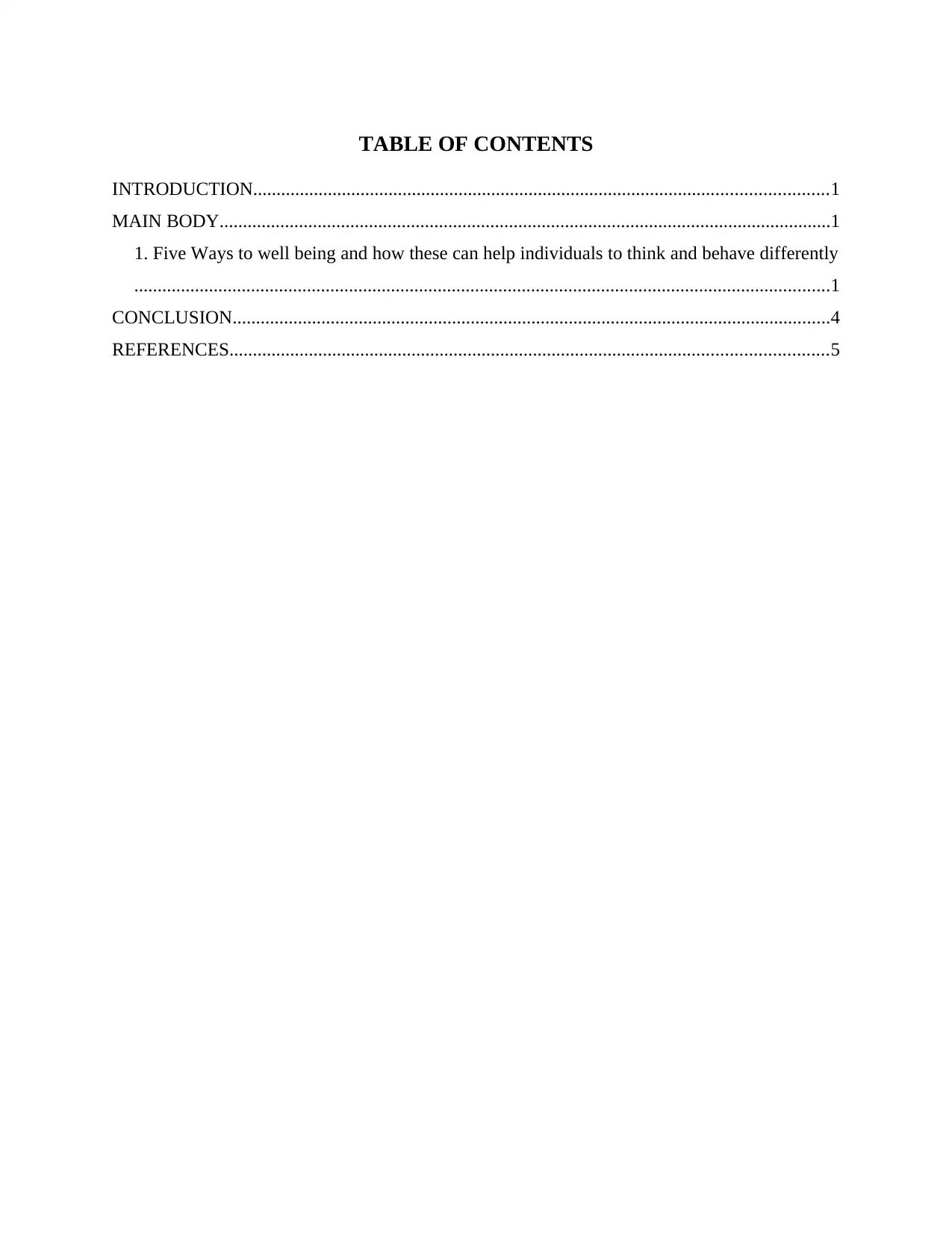
TABLE OF CONTENTS
INTRODUCTION...........................................................................................................................1
MAIN BODY...................................................................................................................................1
1. Five Ways to well being and how these can help individuals to think and behave differently
.....................................................................................................................................................1
CONCLUSION................................................................................................................................4
REFERENCES................................................................................................................................5
INTRODUCTION...........................................................................................................................1
MAIN BODY...................................................................................................................................1
1. Five Ways to well being and how these can help individuals to think and behave differently
.....................................................................................................................................................1
CONCLUSION................................................................................................................................4
REFERENCES................................................................................................................................5
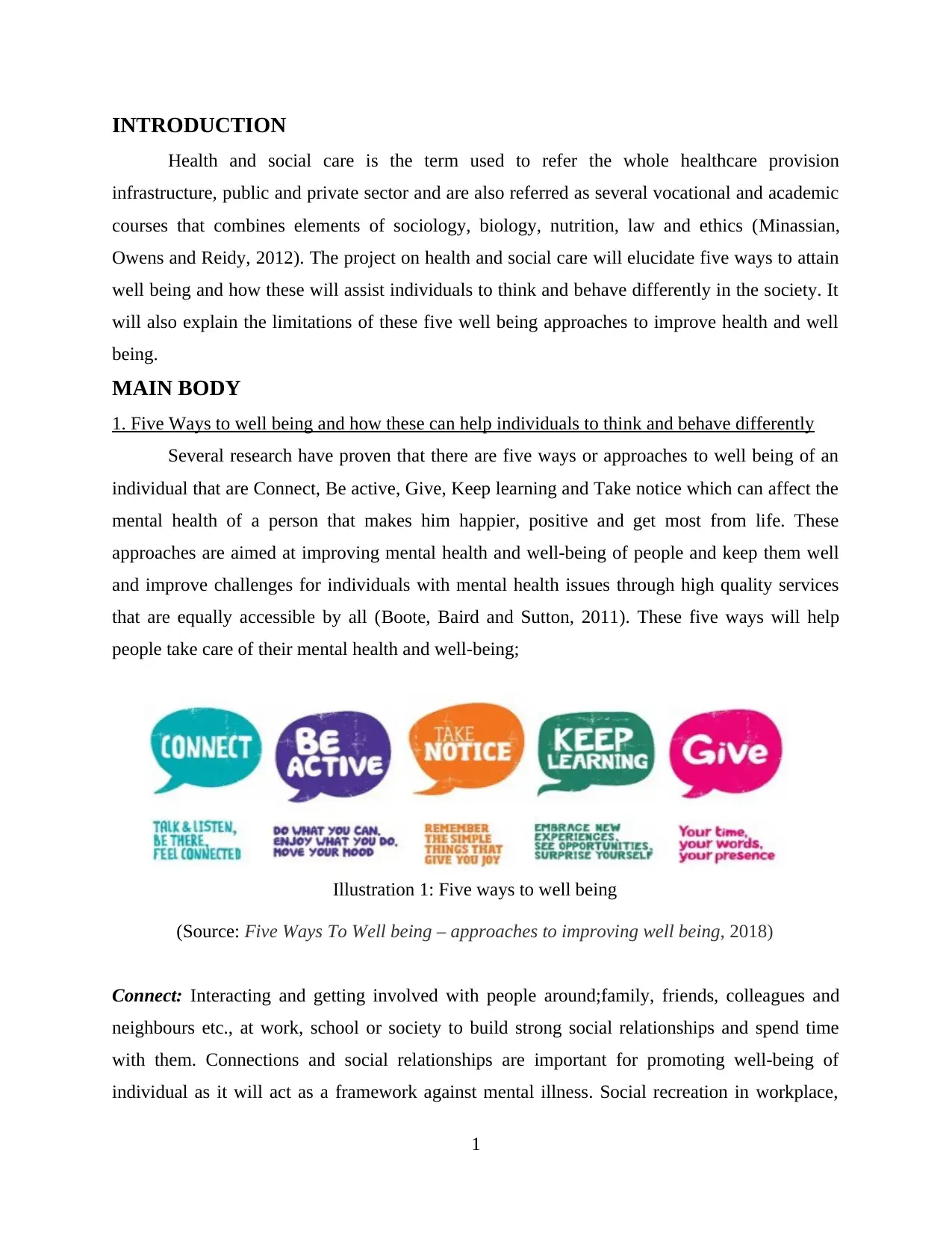
INTRODUCTION
Health and social care is the term used to refer the whole healthcare provision
infrastructure, public and private sector and are also referred as several vocational and academic
courses that combines elements of sociology, biology, nutrition, law and ethics (Minassian,
Owens and Reidy, 2012). The project on health and social care will elucidate five ways to attain
well being and how these will assist individuals to think and behave differently in the society. It
will also explain the limitations of these five well being approaches to improve health and well
being.
MAIN BODY
1. Five Ways to well being and how these can help individuals to think and behave differently
Several research have proven that there are five ways or approaches to well being of an
individual that are Connect, Be active, Give, Keep learning and Take notice which can affect the
mental health of a person that makes him happier, positive and get most from life. These
approaches are aimed at improving mental health and well-being of people and keep them well
and improve challenges for individuals with mental health issues through high quality services
that are equally accessible by all (Boote, Baird and Sutton, 2011). These five ways will help
people take care of their mental health and well-being;
Connect: Interacting and getting involved with people around;family, friends, colleagues and
neighbours etc., at work, school or society to build strong social relationships and spend time
with them. Connections and social relationships are important for promoting well-being of
individual as it will act as a framework against mental illness. Social recreation in workplace,
1
Illustration 1: Five ways to well being
(Source: Five Ways To Well being – approaches to improving well being, 2018)
Health and social care is the term used to refer the whole healthcare provision
infrastructure, public and private sector and are also referred as several vocational and academic
courses that combines elements of sociology, biology, nutrition, law and ethics (Minassian,
Owens and Reidy, 2012). The project on health and social care will elucidate five ways to attain
well being and how these will assist individuals to think and behave differently in the society. It
will also explain the limitations of these five well being approaches to improve health and well
being.
MAIN BODY
1. Five Ways to well being and how these can help individuals to think and behave differently
Several research have proven that there are five ways or approaches to well being of an
individual that are Connect, Be active, Give, Keep learning and Take notice which can affect the
mental health of a person that makes him happier, positive and get most from life. These
approaches are aimed at improving mental health and well-being of people and keep them well
and improve challenges for individuals with mental health issues through high quality services
that are equally accessible by all (Boote, Baird and Sutton, 2011). These five ways will help
people take care of their mental health and well-being;
Connect: Interacting and getting involved with people around;family, friends, colleagues and
neighbours etc., at work, school or society to build strong social relationships and spend time
with them. Connections and social relationships are important for promoting well-being of
individual as it will act as a framework against mental illness. Social recreation in workplace,
1
Illustration 1: Five ways to well being
(Source: Five Ways To Well being – approaches to improving well being, 2018)
⊘ This is a preview!⊘
Do you want full access?
Subscribe today to unlock all pages.

Trusted by 1+ million students worldwide
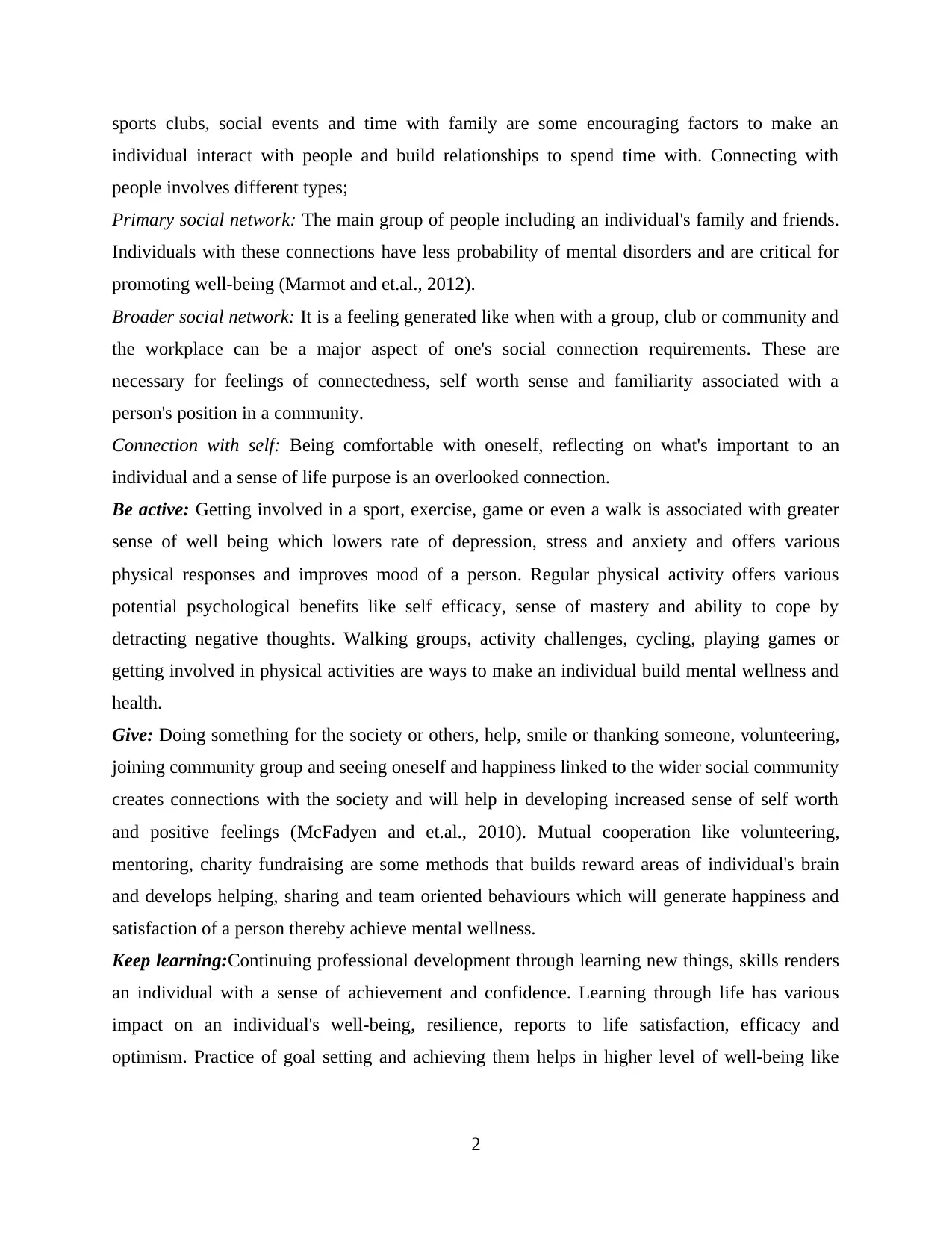
sports clubs, social events and time with family are some encouraging factors to make an
individual interact with people and build relationships to spend time with. Connecting with
people involves different types;
Primary social network: The main group of people including an individual's family and friends.
Individuals with these connections have less probability of mental disorders and are critical for
promoting well-being (Marmot and et.al., 2012).
Broader social network: It is a feeling generated like when with a group, club or community and
the workplace can be a major aspect of one's social connection requirements. These are
necessary for feelings of connectedness, self worth sense and familiarity associated with a
person's position in a community.
Connection with self: Being comfortable with oneself, reflecting on what's important to an
individual and a sense of life purpose is an overlooked connection.
Be active: Getting involved in a sport, exercise, game or even a walk is associated with greater
sense of well being which lowers rate of depression, stress and anxiety and offers various
physical responses and improves mood of a person. Regular physical activity offers various
potential psychological benefits like self efficacy, sense of mastery and ability to cope by
detracting negative thoughts. Walking groups, activity challenges, cycling, playing games or
getting involved in physical activities are ways to make an individual build mental wellness and
health.
Give: Doing something for the society or others, help, smile or thanking someone, volunteering,
joining community group and seeing oneself and happiness linked to the wider social community
creates connections with the society and will help in developing increased sense of self worth
and positive feelings (McFadyen and et.al., 2010). Mutual cooperation like volunteering,
mentoring, charity fundraising are some methods that builds reward areas of individual's brain
and develops helping, sharing and team oriented behaviours which will generate happiness and
satisfaction of a person thereby achieve mental wellness.
Keep learning:Continuing professional development through learning new things, skills renders
an individual with a sense of achievement and confidence. Learning through life has various
impact on an individual's well-being, resilience, reports to life satisfaction, efficacy and
optimism. Practice of goal setting and achieving them helps in higher level of well-being like
2
individual interact with people and build relationships to spend time with. Connecting with
people involves different types;
Primary social network: The main group of people including an individual's family and friends.
Individuals with these connections have less probability of mental disorders and are critical for
promoting well-being (Marmot and et.al., 2012).
Broader social network: It is a feeling generated like when with a group, club or community and
the workplace can be a major aspect of one's social connection requirements. These are
necessary for feelings of connectedness, self worth sense and familiarity associated with a
person's position in a community.
Connection with self: Being comfortable with oneself, reflecting on what's important to an
individual and a sense of life purpose is an overlooked connection.
Be active: Getting involved in a sport, exercise, game or even a walk is associated with greater
sense of well being which lowers rate of depression, stress and anxiety and offers various
physical responses and improves mood of a person. Regular physical activity offers various
potential psychological benefits like self efficacy, sense of mastery and ability to cope by
detracting negative thoughts. Walking groups, activity challenges, cycling, playing games or
getting involved in physical activities are ways to make an individual build mental wellness and
health.
Give: Doing something for the society or others, help, smile or thanking someone, volunteering,
joining community group and seeing oneself and happiness linked to the wider social community
creates connections with the society and will help in developing increased sense of self worth
and positive feelings (McFadyen and et.al., 2010). Mutual cooperation like volunteering,
mentoring, charity fundraising are some methods that builds reward areas of individual's brain
and develops helping, sharing and team oriented behaviours which will generate happiness and
satisfaction of a person thereby achieve mental wellness.
Keep learning:Continuing professional development through learning new things, skills renders
an individual with a sense of achievement and confidence. Learning through life has various
impact on an individual's well-being, resilience, reports to life satisfaction, efficacy and
optimism. Practice of goal setting and achieving them helps in higher level of well-being like
2
Paraphrase This Document
Need a fresh take? Get an instant paraphrase of this document with our AI Paraphraser
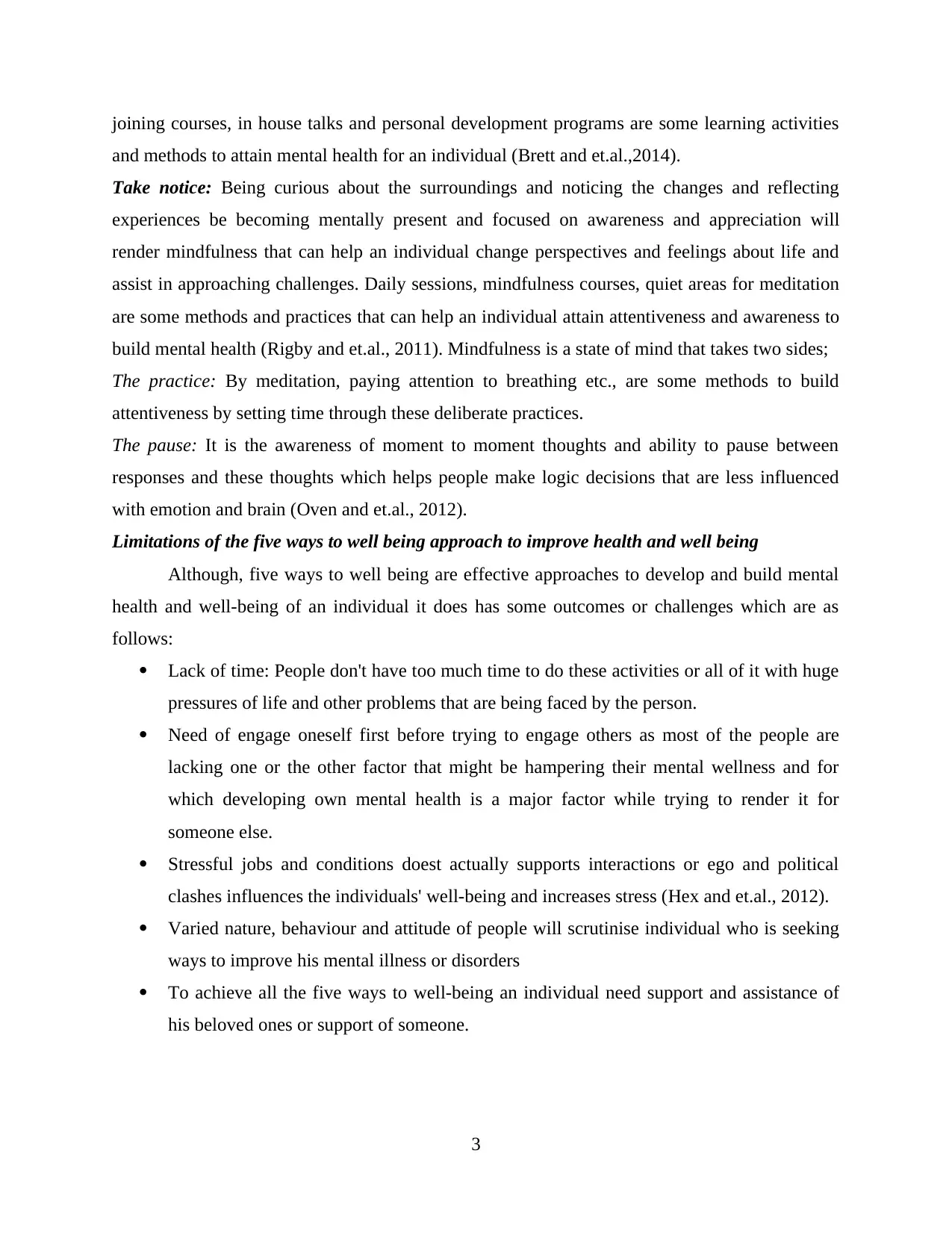
joining courses, in house talks and personal development programs are some learning activities
and methods to attain mental health for an individual (Brett and et.al.,2014).
Take notice: Being curious about the surroundings and noticing the changes and reflecting
experiences be becoming mentally present and focused on awareness and appreciation will
render mindfulness that can help an individual change perspectives and feelings about life and
assist in approaching challenges. Daily sessions, mindfulness courses, quiet areas for meditation
are some methods and practices that can help an individual attain attentiveness and awareness to
build mental health (Rigby and et.al., 2011). Mindfulness is a state of mind that takes two sides;
The practice: By meditation, paying attention to breathing etc., are some methods to build
attentiveness by setting time through these deliberate practices.
The pause: It is the awareness of moment to moment thoughts and ability to pause between
responses and these thoughts which helps people make logic decisions that are less influenced
with emotion and brain (Oven and et.al., 2012).
Limitations of the five ways to well being approach to improve health and well being
Although, five ways to well being are effective approaches to develop and build mental
health and well-being of an individual it does has some outcomes or challenges which are as
follows:
Lack of time: People don't have too much time to do these activities or all of it with huge
pressures of life and other problems that are being faced by the person.
Need of engage oneself first before trying to engage others as most of the people are
lacking one or the other factor that might be hampering their mental wellness and for
which developing own mental health is a major factor while trying to render it for
someone else.
Stressful jobs and conditions doest actually supports interactions or ego and political
clashes influences the individuals' well-being and increases stress (Hex and et.al., 2012).
Varied nature, behaviour and attitude of people will scrutinise individual who is seeking
ways to improve his mental illness or disorders
To achieve all the five ways to well-being an individual need support and assistance of
his beloved ones or support of someone.
3
and methods to attain mental health for an individual (Brett and et.al.,2014).
Take notice: Being curious about the surroundings and noticing the changes and reflecting
experiences be becoming mentally present and focused on awareness and appreciation will
render mindfulness that can help an individual change perspectives and feelings about life and
assist in approaching challenges. Daily sessions, mindfulness courses, quiet areas for meditation
are some methods and practices that can help an individual attain attentiveness and awareness to
build mental health (Rigby and et.al., 2011). Mindfulness is a state of mind that takes two sides;
The practice: By meditation, paying attention to breathing etc., are some methods to build
attentiveness by setting time through these deliberate practices.
The pause: It is the awareness of moment to moment thoughts and ability to pause between
responses and these thoughts which helps people make logic decisions that are less influenced
with emotion and brain (Oven and et.al., 2012).
Limitations of the five ways to well being approach to improve health and well being
Although, five ways to well being are effective approaches to develop and build mental
health and well-being of an individual it does has some outcomes or challenges which are as
follows:
Lack of time: People don't have too much time to do these activities or all of it with huge
pressures of life and other problems that are being faced by the person.
Need of engage oneself first before trying to engage others as most of the people are
lacking one or the other factor that might be hampering their mental wellness and for
which developing own mental health is a major factor while trying to render it for
someone else.
Stressful jobs and conditions doest actually supports interactions or ego and political
clashes influences the individuals' well-being and increases stress (Hex and et.al., 2012).
Varied nature, behaviour and attitude of people will scrutinise individual who is seeking
ways to improve his mental illness or disorders
To achieve all the five ways to well-being an individual need support and assistance of
his beloved ones or support of someone.
3
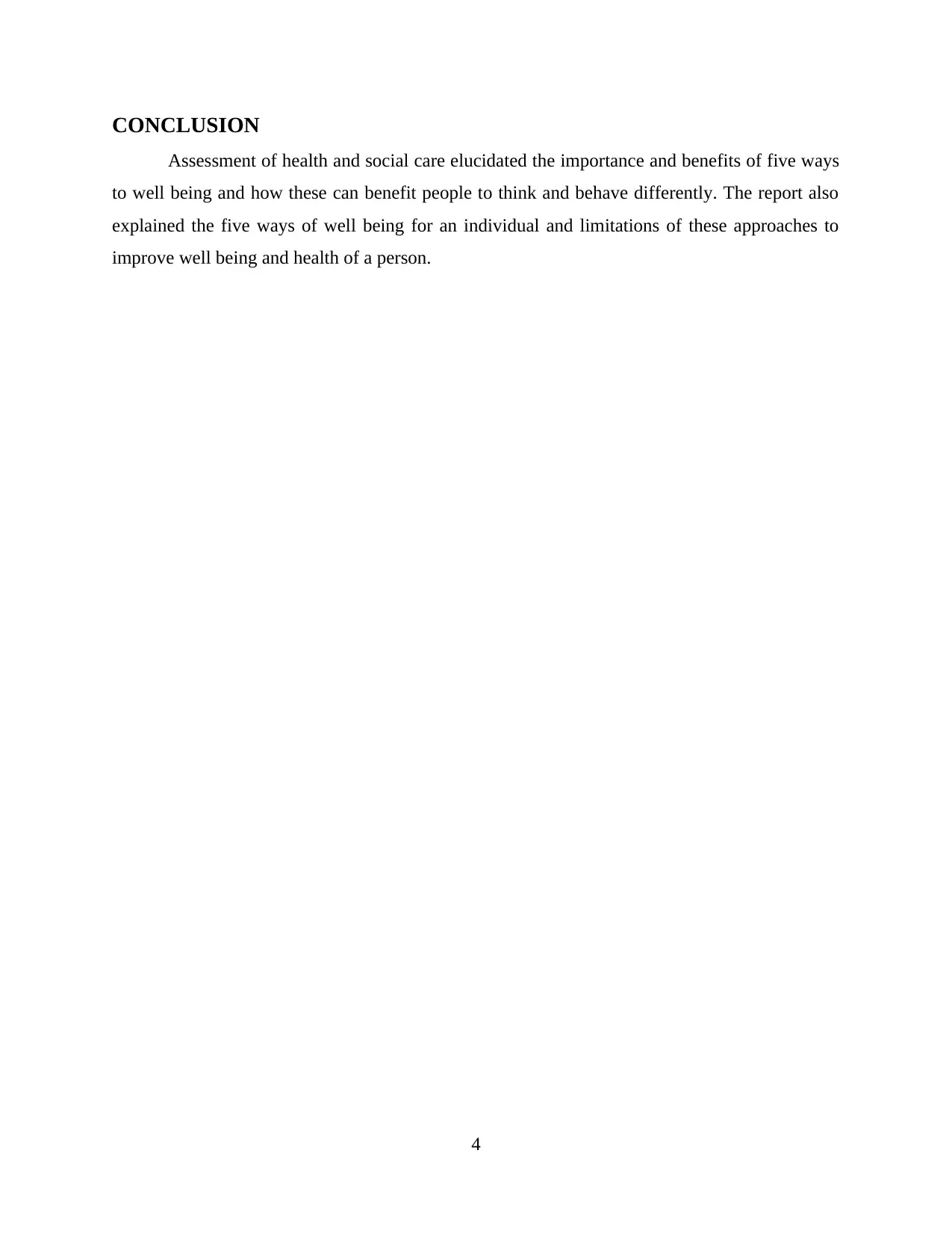
CONCLUSION
Assessment of health and social care elucidated the importance and benefits of five ways
to well being and how these can benefit people to think and behave differently. The report also
explained the five ways of well being for an individual and limitations of these approaches to
improve well being and health of a person.
4
Assessment of health and social care elucidated the importance and benefits of five ways
to well being and how these can benefit people to think and behave differently. The report also
explained the five ways of well being for an individual and limitations of these approaches to
improve well being and health of a person.
4
⊘ This is a preview!⊘
Do you want full access?
Subscribe today to unlock all pages.

Trusted by 1+ million students worldwide
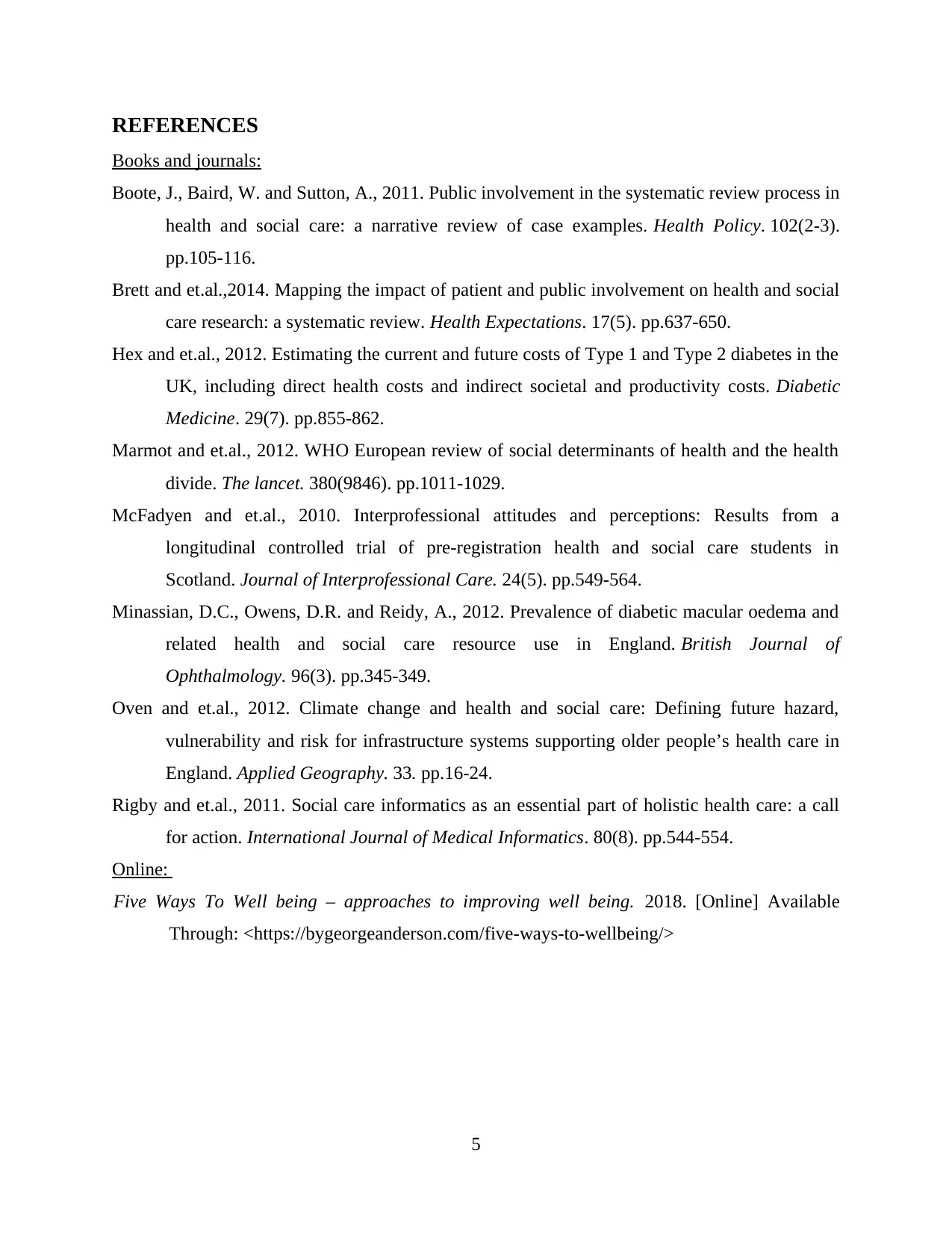
REFERENCES
Books and journals:
Boote, J., Baird, W. and Sutton, A., 2011. Public involvement in the systematic review process in
health and social care: a narrative review of case examples. Health Policy. 102(2-3).
pp.105-116.
Brett and et.al.,2014. Mapping the impact of patient and public involvement on health and social
care research: a systematic review. Health Expectations. 17(5). pp.637-650.
Hex and et.al., 2012. Estimating the current and future costs of Type 1 and Type 2 diabetes in the
UK, including direct health costs and indirect societal and productivity costs. Diabetic
Medicine. 29(7). pp.855-862.
Marmot and et.al., 2012. WHO European review of social determinants of health and the health
divide. The lancet. 380(9846). pp.1011-1029.
McFadyen and et.al., 2010. Interprofessional attitudes and perceptions: Results from a
longitudinal controlled trial of pre-registration health and social care students in
Scotland. Journal of Interprofessional Care. 24(5). pp.549-564.
Minassian, D.C., Owens, D.R. and Reidy, A., 2012. Prevalence of diabetic macular oedema and
related health and social care resource use in England. British Journal of
Ophthalmology. 96(3). pp.345-349.
Oven and et.al., 2012. Climate change and health and social care: Defining future hazard,
vulnerability and risk for infrastructure systems supporting older people’s health care in
England. Applied Geography. 33. pp.16-24.
Rigby and et.al., 2011. Social care informatics as an essential part of holistic health care: a call
for action. International Journal of Medical Informatics. 80(8). pp.544-554.
Online:
Five Ways To Well being – approaches to improving well being. 2018. [Online] Available
Through: <https://bygeorgeanderson.com/five-ways-to-wellbeing/>
5
Books and journals:
Boote, J., Baird, W. and Sutton, A., 2011. Public involvement in the systematic review process in
health and social care: a narrative review of case examples. Health Policy. 102(2-3).
pp.105-116.
Brett and et.al.,2014. Mapping the impact of patient and public involvement on health and social
care research: a systematic review. Health Expectations. 17(5). pp.637-650.
Hex and et.al., 2012. Estimating the current and future costs of Type 1 and Type 2 diabetes in the
UK, including direct health costs and indirect societal and productivity costs. Diabetic
Medicine. 29(7). pp.855-862.
Marmot and et.al., 2012. WHO European review of social determinants of health and the health
divide. The lancet. 380(9846). pp.1011-1029.
McFadyen and et.al., 2010. Interprofessional attitudes and perceptions: Results from a
longitudinal controlled trial of pre-registration health and social care students in
Scotland. Journal of Interprofessional Care. 24(5). pp.549-564.
Minassian, D.C., Owens, D.R. and Reidy, A., 2012. Prevalence of diabetic macular oedema and
related health and social care resource use in England. British Journal of
Ophthalmology. 96(3). pp.345-349.
Oven and et.al., 2012. Climate change and health and social care: Defining future hazard,
vulnerability and risk for infrastructure systems supporting older people’s health care in
England. Applied Geography. 33. pp.16-24.
Rigby and et.al., 2011. Social care informatics as an essential part of holistic health care: a call
for action. International Journal of Medical Informatics. 80(8). pp.544-554.
Online:
Five Ways To Well being – approaches to improving well being. 2018. [Online] Available
Through: <https://bygeorgeanderson.com/five-ways-to-wellbeing/>
5
Paraphrase This Document
Need a fresh take? Get an instant paraphrase of this document with our AI Paraphraser

6
1 out of 8
Related Documents
Your All-in-One AI-Powered Toolkit for Academic Success.
+13062052269
info@desklib.com
Available 24*7 on WhatsApp / Email
![[object Object]](/_next/static/media/star-bottom.7253800d.svg)
Unlock your academic potential
Copyright © 2020–2025 A2Z Services. All Rights Reserved. Developed and managed by ZUCOL.





